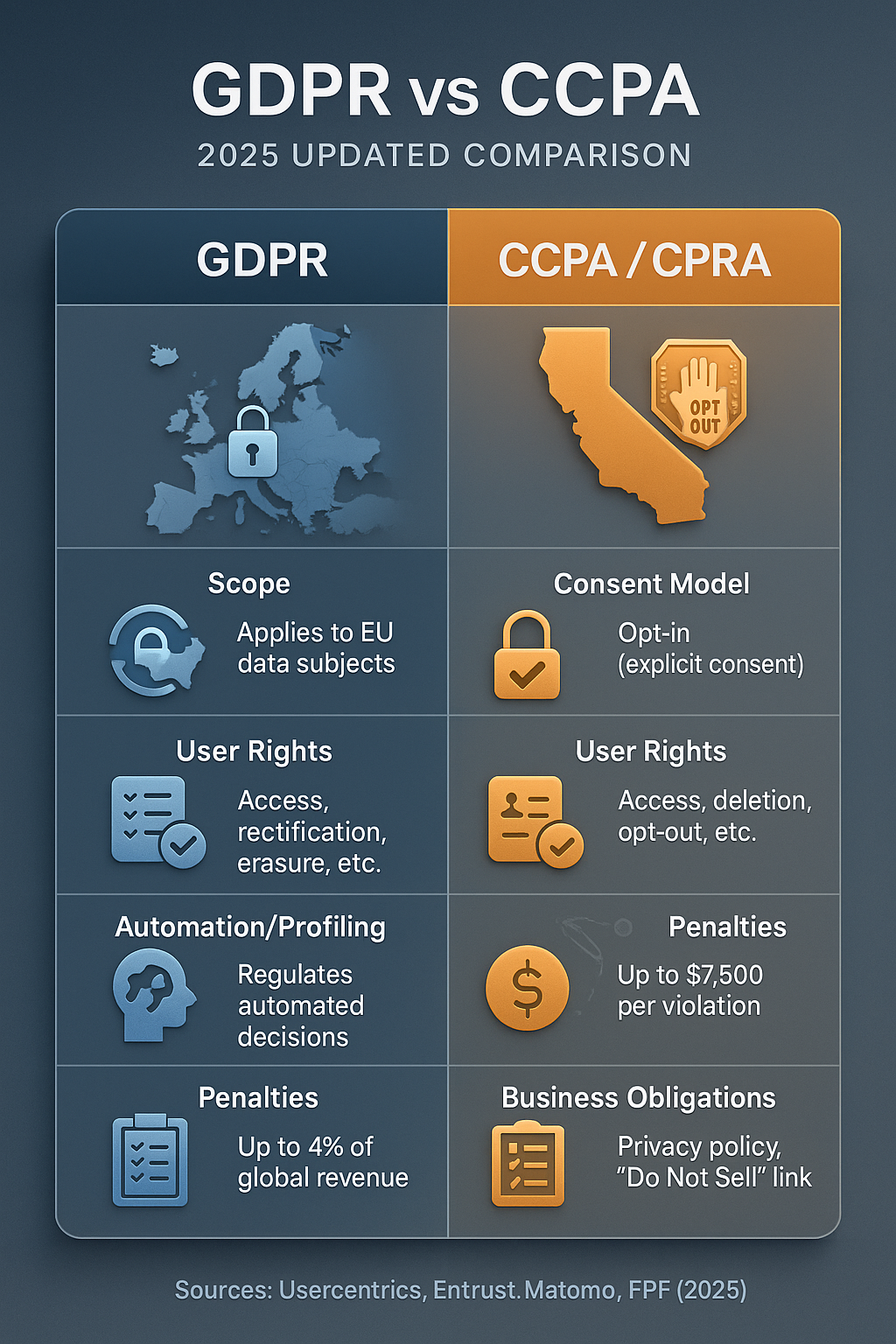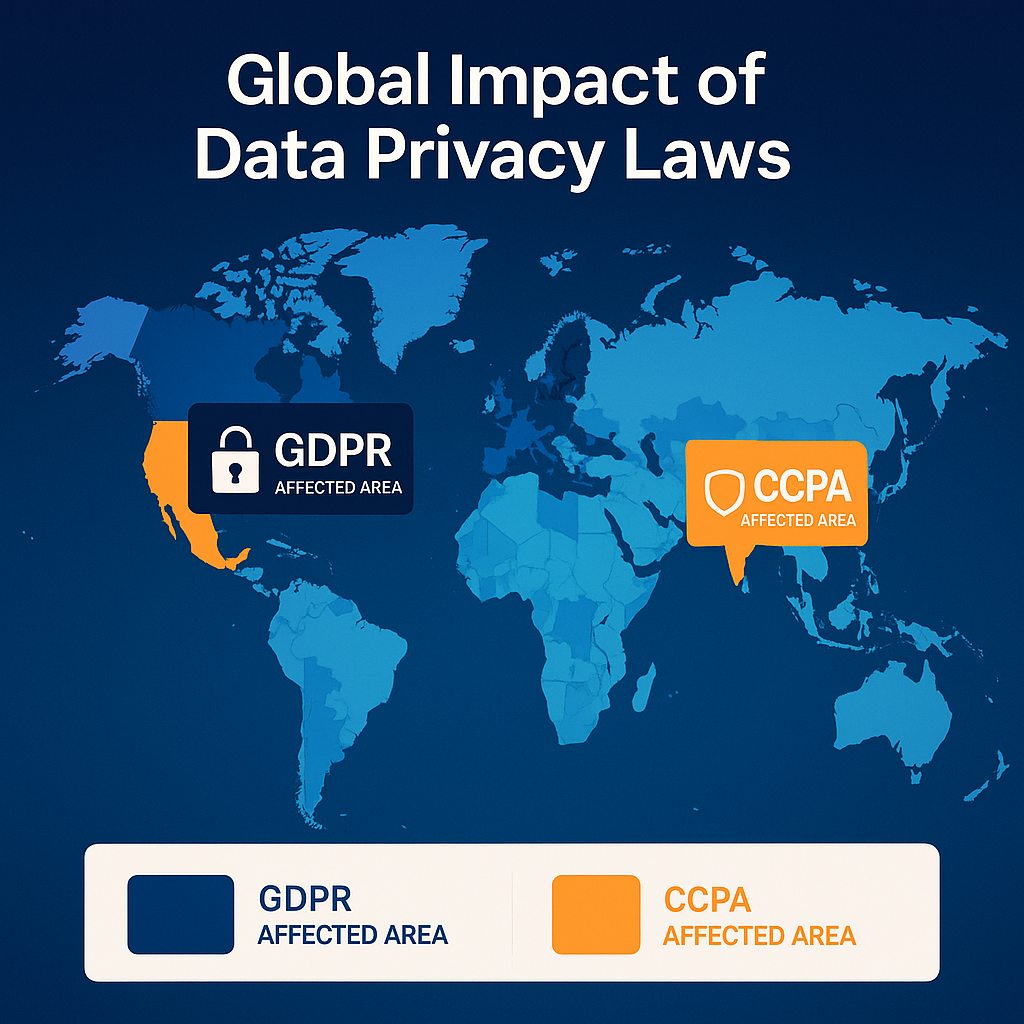GDPR vs CCPA 2025: Clear Differences, Compliance for WordPress
In the digital era, privacy is a competitive advantage—not just a legal checkbox. If your WordPress site attracts EU visitors (GDPR) or California residents (CCPA/CPRA), you must understand how these laws diverge and what that means for AdSense and analytics. This 2025 guide breaks down GDPR vs CCPA in plain English and gives you a practical, copy-ready checklist to keep your site compliant while maintaining ad revenue.
What Exactly Are GDPR and CCPA?
GDPR (EU General Data Protection Regulation)
Effective since May 25, 2018, GDPR governs how organizations collect, use, store, and share personal data of people in the EU/EEA—no matter where your business is located. It pushes strong principles like data minimization, purpose limitation, and “privacy by design/default.” In practice, this often means you need prior, explicit consent for non-essential cookies (e.g., ad personalization) and must honor data subject rights (access, deletion, portability, objection, etc.).
CCPA, as amended by CPRA (California)
Effective since January 1, 2020 (with CPRA enhancements later), CCPA focuses on giving Californians transparency and control, particularly around the sale or sharing of personal information. It’s generally an opt-out model: you can collect data unless the user opts out of certain uses. It also requires a clear “Do Not Sell or Share My Personal Information” mechanism for applicable businesses.
Key Differences You Should Know (2025 View)
1) Consent Model
GDPR: Opt-in for most non-essential tracking—no dropping ad/analytics cookies until consent.
CCPA/CPRA: Opt-out for sale/sharing; you may load scripts, but you must provide an easy opt-out and honor it (including signals like GPC, where applicable).
2) Scope & Applicability
GDPR: Based on the location of the user (EU/EEA residents) and processing activities that target them.
CCPA/CPRA: Based on business thresholds (revenue, volume of Californians’ data, % of revenue from data sales/sharing) and doing business in California.
3) Individual Rights
GDPR: Access, rectification, erasure (“right to be forgotten”), restriction, objection, portability, and limits on solely automated decisions.
CCPA/CPRA: Right to know, delete, correct, opt out of sale/sharing, and non-discrimination for exercising rights.
What Changed Recently (Why 2025 Matters)
- AI & profiling scrutiny: EU guidance continues to tighten around transparency and fairness in automated decision-making. If you use behavioral ads or AI-driven personalization, expect more disclosure and consent requirements.
- Consent-or-Pay: EU regulators have increasingly criticized models that force users to either accept tracking or pay, especially for large platforms. For most publishers, a balanced consent UX remains safer.
- US state patchwork: Beyond California, more US states are passing privacy laws. If you have significant US traffic, adopt a scalable, signals-aware consent strategy (e.g., honor GPC, respect regional rules).
WordPress + AdSense: A Practical Compliance Blueprint
1) Build a Region-Aware Consent Layer
- EU/EEA visitors: Block non-essential scripts (ad personalization, retargeting, many analytics cookies) until explicit consent. Offer granular toggles (Ads, Analytics, Personalization) and a clean “Reject All.”
- California visitors: Load your site normally, but prominently offer a Do Not Sell or Share control and honor opt-out signals. If you use IAB GPP/USP frameworks, wire them correctly so ad partners respect the signal.
- Everyone else: Keep your base banner simple, with easy access to preferences. Don’t bury the controls.
2) Configure AdSense the Right Way
- Consent mode compatibility: Use Consent Mode / region signals so AdSense can serve non-personalized ads when required (protecting revenue without violating rules).
- Label your inventory: Make sure any “limited ads” or non-personalized paths are tested. Check that your CMP actually passes consent strings that AdSense understands.
- Avoid dark patterns: Don’t pressure users into “Accept.” Clear language and symmetry between “Accept” and “Reject” reduce risk and improve trust.
3) Update Policies & Disclosures
- Privacy Policy: List categories of data collected, purposes, retention, vendors (ad/analytics partners), and user rights (EU and California). Link it site-wide (footer + banner).
- Do Not Sell/Share page: Provide a simple form or toggle for Californians. Explain what “sale/share” means in plain terms.
- Cookie Policy: Categorize cookies, lifetimes, and providers; explain how to change preferences later.
4) Engineer for Data Minimization
- Reduce identifiers where possible; use IP anonymization and server-side tagging judiciously.
- Disable unneeded features in plugins; audit what each script collects.
- Adopt a “default to least data” mindset and expand only as truly needed.
Conclusion
GDPR and CCPA offer overlapping but distinct frameworks for data protection. GDPR is broader, more stringent, and demands deeper accountability, while CCPA focuses on consumer control over data sales and is tied to business thresholds. In 2025, with increased regulatory scrutiny and evolving AI profiling standards, site owners must proactively ensure compliance—especially if targeting international users.
For WordPress or AdSense-based sites, proper consent management, clear privacy policies, and careful data handling practices are non-negotiable. That compliance not only avoids legal risks—it builds user trust.
References / Sources
- Entrust: “CCPA vs GDPR Compliance: What’s the Difference?”
- Usercentrics: “CCPA vs GDPR: Key Differences and Similarities”
- Future of Privacy Forum (FPF): “Comparing privacy laws: GDPR v. CCPA” (PDF)

